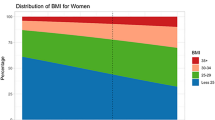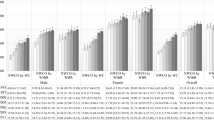Abstract
The objective of this study was to measure change in obesity prevalence among New York City (NYC) adults from 2004 to 2013–2014 and assess variation across sociodemographic subgroups. We used objectively measured height and weight data from the NYC Health and Nutrition Examination Survey to calculate relative percent change in obesity (≥ 30 kg/m2) between 2004 (n = 1987) and 2013–2014 (n = 1489) among all NYC adults and sociodemographic subgroups. We also examined changes in self-reported proxies for energy imbalance. Estimates were age-standardized and statistical significance was evaluated using two-tailed T tests and multivariable regression (p < 0.05). Between 2004 and 2013–2014, obesity increased from 27.5 to 32.4% (p = 0.01). Prevalence remained stable and high among women (31.2 to 32.8%, p = 0.53), but increased among men (23.4 to 32.0%, p = 0.002), especially among non-Latino White men and men age ≥ 65 years. Black adults had the highest prevalence in 2013–2014 (37.1%) and Asian adults experienced the largest increase (20.1 to 29.2%, p = 0.06), especially Asian women. Foreign-born participants and participants lacking health insurance also had large increases in obesity. We observed increases in eating out and screen time over time and no improvements in physical activity. Our findings show increases in obesity in NYC in the past decade, with important sociodemographic differences.

Similar content being viewed by others
Change history
20 August 2018
Readers should note the following two typographical errors in this article.
References
Flegal KM, Carroll MD, Ogden CL, Johnson CL. Prevalence and trends in obesity among US adults, 1999–2000. JAMA. 2002;288(14):1723–7.
Flegal KM, Kruszon-Moran D, Carroll MD, Fryar CD, Ogden CL. Trends in obesity among adults in the United States, 2005 to 2014. JAMA. 2016;315(21):2284–91.
Kuczmarski RJ, Flegal KM, Campbell SM, Johnson CL. Increasing prevalence of overweight among US adults: the National Health and Nutrition Examination Surveys, 1960 to 1991. JAMA. 1994;272(3):205–11.
Ogden CL, Carroll MD, Curtin LR, McDowell MA, Tabak CJ, Flegal KM. Prevalence of overweight and obesity in the United States, 1999–2004. JAMA. 2006;295(13):1549–55.
Romero CX, Romero TE, Shlay JC, Ogden LG, Dabelea D. Changing trends in the prevalence and disparities of obesity and other cardiovascular disease risk factors in three racial/ethnic groups of USA adults. Adv Prev Med. 2012;2012:1–8.
National Heart, Lung, and Blood Institute. Managing overweight and obesity in adults: aystematic evidence review from the obesity expert panel, 2013. US Department of Health and Human Services. National Institutes of Health. Bethesda, Maryland; 2013.
Executive summary: guidelines (2013) for the management of overweight and obesity in adults. Obesity. 2014;(22 Suppl 2):S5–39.
Pratt CA, Loria CM, Arteaga SS, Nicastro HL, Lopez-Class M, de Jesus JM, et al. A systematic review of obesity disparities research. Am J Prev Med. 2017;53(1):113–22.
Caprio S, Daniels SR, Drewnowski A, Kaufman FR, Palinkas LA, Rosenbloom AL, et al. Influence of race, ethnicity, and culture on childhood obesity: implications for prevention and treatment. Obesity (Silver Spring, Md). 2008;16(12):2566–77.
Asghari G, Mirmiran P, Yuzbashian E, Azizi F. A systematic review of diet quality indices in relation to obesity. Br J Nutr. 2017;117(8):1055–65.
de Rezende LFM, Lopes MR, Rey-López JP, Matsudo VKR, do Carmo Luiz O. Sedentary behavior and health outcomes: an overview of systematic reviews. PLoS One. 2014;9(8):e105620.
Shaw KA, Gennat HC, O’Rourke P, Del Mar C. Exercise for overweight or obesity. Cochrane Libr. 2006;
Ledoux T, Hingle M, Baranowski T. Relationship of fruit and vegetable intake with adiposity: a systematic review. Obes Rev. 2011;12(5):e143–50.
Nago ES, Lachat CK, Dossa RA, Kolsteren PW. Association of out-of-home eating with anthropometric changes: a systematic review of prospective studies. Crit Rev Food Sci Nutr. 2014;54(9):1103–16.
Mytton OT, Nnoaham K, Eyles H, Scarborough P, Mhurchu CN. Systematic review and meta-analysis of the effect of increased vegetable and fruit consumption on body weight and energy intake. BMC Public Health. 2014;14(1):886.
Thorp AA, Owen N, Neuhaus M, Dunstan DW. Sedentary behaviors and subsequent health outcomes in adults a systematic review of longitudinal studies, 1996–2011. Am J Prev Med. 2011;41(2):207–15.
Rehm CD, Peñalvo JL, Afshin A, Mozaffarian D. Dietary intake among US adults, 1999–2012. JAMA. 2016;315(23):2542–53.
Wang DD, Leung CW, Li Y, Ding EL, Chiuve SE, Hu FB, et al. Trends in dietary quality among adults in the United States, 1999 through 2010. JAMA Intern Med. 2014;174(10):1587–95.
Ford ES, Dietz WH. Trends in energy intake among adults in the United States: findings from NHANES. Am J Clin Nutr. 2013;97(4):848–53.
Ladabaum U, Mannalithara A, Myer PA, Singh G. Obesity, abdominal obesity, physical activity, and caloric intake in US adults: 1988 to 2010. Am J Med. 2014;127(8):717–727.e12.
Kelly PM, Davies A, Greig AJ, Lee KK. Obesity prevention in a city state: lessons from New York City during the Bloomberg Administration. Front Public Health. 2016;4:60.
New York City Department of Parks and Recreation. Shape Up NYC. Date Accessed: 1/29/2018. Available from: https://www.nycservice.org/initiatives/index.php?bitinitiative_id=15.
New York City Department of Health and Mental Hygiene. Health Bucks. Available from: https://www1.nyc.gov/site/doh/health/health-topics/health-bucks.page. Accessed 22 May 2018.
Thorpe LE, Greene C, Freeman A, Snell E, Rodriguez-Lopez JS, Frankel M, et al. Rationale, design and respondent characteristics of the 2013–2014 New York City Health and Nutrition Examination Survey (NYC HANES 2013–2014). Prev Med Rep. 2015;2:580–5.
Thorpe LE, Gwynn RC, Mandel-Ricci J, Roberts S, Tsoi B, Berman L, et al. Study design and participation rates of the New York City Health and Nutrition Examination Survey, 2004. Prev Chronic Dis. 2006;3(3):A94.
Centers for Disease Control and Prevention (CDC). National Center for Health Statistics (NCHS). National Health and Nutrition Examination Survey Data. Hyattsville, MD: U.S. Department of Health and Human Services, Centers for Disease Control and Prevention. Available from: https://www.cdc.gov/nchs/nhanes/nhanes_questionnaires.htm. Accessed 2 Feb 2018.
Appropriate body-mass index for Asian populations and its implications for policy and intervention strategies. Lancet (London, England). 2004;363(9403):157–63.
National Health and Nutrition Examination Survey (NHANES): Physician Examination Procedures Manual. Available from: https://www.cdc.gov/nchs/data/nhanes/nhanes_13_14/Phys_Exam_Manual_2013.pdf. Accessed 2 Feb 2018.
Prevention OoD, Promotion H. Healthy People 2020. Washington, DC: US Department of Health and Human Services. 2013.
U.S. Department of Health and Human Services, Office of Disease Prevention and Health Promotion. Healthy People 2010. Washington, DC Date Accessed: 7/27/2017. Available from: https://www.cdc.gov/nchs/healthy_people/hp2010.htm.
Budtz-Jorgensen E, Keiding N, Grandjean P, Weihe P. Confounder selection in environmental epidemiology: assessment of health effects of prenatal mercury exposure. Ann Epidemiol. 2007;17(1):27–35.
Shields M, Connor Gorber S, Tremblay MS. Estimates of obesity based on self-report versus direct measures. Health Rep. 2008;19(2):61–76.
Black JL, Macinko J. The changing distribution and determinants of obesity in the neighborhoods of New York City, 2003-2007. Am J Epidemiol. 2010;171(7):765–75.
Fakhouri TH, Ogden CL, Carroll MD, Kit BK, Flegal KM. Prevalence of obesity among older adults in the United States, 2007–2010. US Department of Health and Human Services, Centers for Disease Control and Prevention, National Center for Health Statistics. Hyattsville, MD; 2012.
Fryar CD, Carroll MD, Ogden CL. Prevalence of overweight, obesity, and extreme obesity among adults: United States, trends 1960–1962 through 2009–2010. Hyattsville, MD: National Center for Health Statistics; 2012.
Seguin RA, Aggarwal A, Vermeylen F, Drewnowski A. Consumption frequency of foods away from home linked with higher body mass index and lower fruit and vegetable intake among adults: a cross-sectional study. J Environ Public Health. 2016;2016:1–12.
Park Y, Neckerman KM, Quinn J, Weiss C, Rundle A. Place of birth, duration of residence, neighborhood immigrant composition and body mass index in New York City. Int J Behav Nutr Phys Act. 2008;5(1):19.
Dee A, Kearns K, O'Neill C, Sharp L, Staines A, O'Dwyer V, et al. The direct and indirect costs of both overweight and obesity: a systematic review. BMC Res Notes. 2014;7:242.
Doucette ED, Salas J, Scherrer JF. Insurance coverage and diabetes quality indicators among patients in NHANES. Am J Manag Care. 2016;22(7):484–90.
Winkler MR, Mason S, Laska MN, Christoph MJ, Neumark-Sztainer D. Does non-standard work mean non-standard health? Exploring links between non-standard work schedules, health behavior, and well-being. SSM Popul Health. 2018;4:135–43.
Wing RR, Phelan S. Long-term weight loss maintenance. Am J Clin Nutr. 2005;82(1):222S–5S.
Acknowledgments
Support for NYCHANES 2013–2014 was provided by the de Beaumont Foundation with additional support from the Robert Wood Johnson Foundation, Robin Hood, the NYS Health Foundation, Quest Diagnostics, and the Doris Duke Charitable Foundation, NYC Health Department, Hunter College Office of the Provost, CUNY Vice Chancellors Office of Research, and CUNY School of Public Health Dean’s Office.
Author information
Authors and Affiliations
Corresponding author
Appendix
Appendix
Rights and permissions
About this article
Cite this article
Rummo, P., Kanchi, R., Perlman, S. et al. Change in Obesity Prevalence among New York City Adults: the NYC Health and Nutrition Examination Survey, 2004 and 2013–2014. J Urban Health 95, 787–799 (2018). https://doi.org/10.1007/s11524-018-0288-9
Published:
Issue Date:
DOI: https://doi.org/10.1007/s11524-018-0288-9




